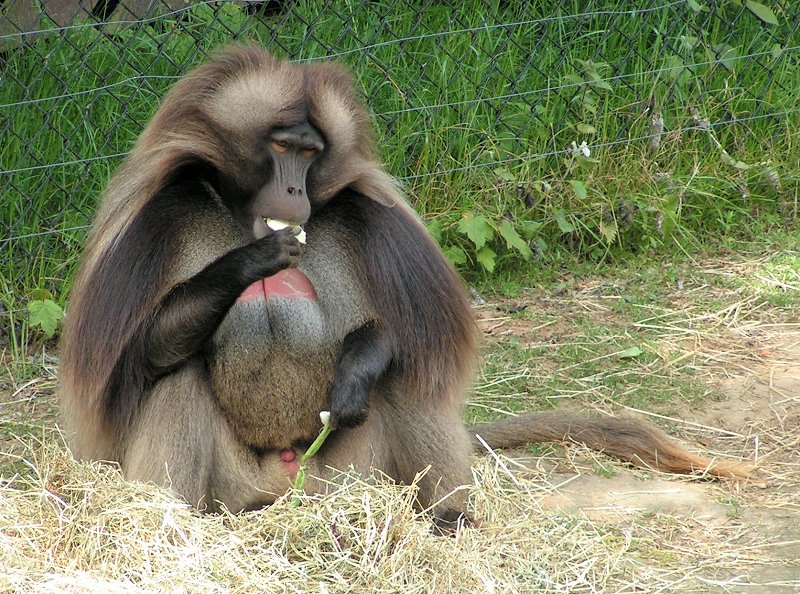Gelada Baboon (Theropithecus gelada) - Wiki Gelada
From Wikipedia, the free encyclopedia
[Photo] Gelada Baboon (Theropithecus gelada). Male. Colchester Zoo, 2 June 2004. Photo by sannse http://commons.wikimedia.org/wiki/User:Sannse
The Gelada (Theropithecus gelada) is a species of Old World monkey, found only in the Ethiopian Highlands of Ethiopia and Eritrea, with large populations in the Semien Mountains. Like its close relative, the baboon, it is terrestrial and spends its time foraging in grasslands. Some authorities used to group the Gelada with baboons in the genus Papio, but since 1979 it has become customary to place them in a separate genus, Theropithecus. Theropithecus gelada is the only living species, but at least two separate lineages are known in the fossil record. While the Gelada is restricted to Ethiopia and Eritrea today, fossils of the genus are known from South Africa, Malawi, Democratic Republic of the Congo, Tanzania, Uganda, Kenya, Ethiopia, Algeria, Morocco, Spain, and India.
Theropithecus gelada can be distinguished from baboons by the bright patch of skin on its chest. The patch is hourglass-shaped, and on males, it is bright red and surrounded by white hair. On females, the patch is far less pronounced. However, when in heat, the female's patch will brighten, and a "necklace" of fluid-filled blisters forms on the patch. This is thought to be similar to the swelling on the buttocks during oestrus that is common to most baboons. This modification probably evolved because the Gelada spends almost all its life in a sitting position, with the buttocks hidden, so that it cannot serve as a visual cue. The male Gelada's tail is about as long as the body and densely tufted at the tip; it also has a long and flowing mantle and mane.
The Gelada lives in small groups with one male, and several females and their offspring. These small bands often join together to feed, creating groups of upwards of 350 individual monkeys. At especially good feeding spots, group of upwards of 670 individuals have been observed.
The Gelada is primarily a grass-eater, eating every part of the plant, from the seeds, to the roots, to the stalk. It has the most well developed opposable thumbs of any of the Old World monkeys, which allows it to pick apart grasses with great dexterity to find the nourishing parts. It has also been known to eat fruit on occasion.
Although not listed as endangered, only 50-60,000 Geladas are known to exist. Hunting and habitat destruction have forced the Gelada into areas formerly inhabited by the Olive Baboon, and hybridisation between the two groups has been observed. In addition, in the southern part of the Amhara plateau, Gelada males are killed every two years in order to use their manes in a coming-of-age ceremony. The loss of much of the adult male population on a regular basis has disrupted the population of the species.
There are two subspecies of Gelada:
- Theropithecus gelada gelada
- Eastern Gelada, Theropithecus gelada obscurus
http://en.wikipedia.org/wiki/Gelada_Baboon
| The text in this page is based on the copyrighted Wikipedia article shown in above URL. It is used under the GNU Free Documentation License. You may redistribute it, verbatim or modified, providing that you comply with the terms of the GFDL. |
